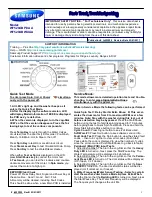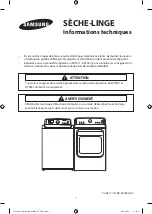
41
Tea or lipstick residue on the
dishes.
Too low rinsing temperature.
Select wash cycle with higher washing tem-
perature.
Too little or unsuitable detergent.
Use suitable detergent at correct dosage.
Dishes precleaned too intensely;
sensors therefore decide on weak
wash cycle sequence. Stubborn
soiling cannot be completely
removed.
Do not prerinse dishes. Remove only large
food soils.
Increase sensitivity of the sensors.
Recommended wash cycle "Regular".
Colored (blue, yellow, brown),
film in the dishwasher or on
stainless steel cutlery/cook-
ware.
Film from mixture of food and min-
eral deposits.
Can be partly removed with dishwasher
cleaner or by mechanical cleaning.
Film formed by oxidation of silver or
aluminum cookware.
Can be partly removed with dishwasher
cleaner or by mechanical cleaning.
Colored (yellow, orange,
brown), easily removable film
inside the appliance (mainly
in the floor area).
Soapy film from mixture of food and
hard water.
Use water softener* - refill with salt or increase
setting where necessary. Use dishwasher
detergent instead of a 3 in 1 or Eco detergent.
Plastic parts stained or discol-
ored.
Plastic parts inside the appliance
may become discolored during the
service life of the dishwasher.
Discoloration is normal and will not impair the
function of the dishwasher.
Too low rinsing temperature.
Select wash cycle with higher washing tem-
perature.
Dishes precleaned too intensely;
sensors therefore decide on weak
wash cycle sequence. Stubborn
soiling cannot be completely
removed.
Do not prerinse dishes. Remove only large
food soils.
Increase sensitivity of the sensors.
Recommended wash cycle "Regular".
Removable streaks on
glasses, glasses with metal-
lic appearance and silver-
ware.
Too much rinse aid.
Set rinse aid amount to lower setting.
No rinse aid added or setting too
low.
Add rinse aid and check dosage (recom-
mended setting 4–5).
Detergent residue in the final rinse
wash cycle section. Detergent dis-
penser cover blocked by dishes
(cover does not open fully).
Detergent dispenser cover must not be
obstructed by dishes.
Do not place dishes or fragrance dispenser in
the detergent tab tray.
Dishes precleaned too intensely;
sensors therefore decide on weak
wash cycle sequence. Stubborn
soiling cannot be completely
removed.
Do not prerinse dishes. Remove only large
food soils.
Increase sensitivity of the sensors.
Recommended wash cycle “Regular”.
Initial or existing, irreversible
clouding of glass.
Glasses not dishwasher-proof, only
suitable for dishwasher.
Use dishwasher-proof glasses.
Avoid long steam phase (standing time after
wash cycle ends).
Use wash cycle at lower temperature.
Set water softening system according to the
water hardness (if required one setting lower).
Use detergent with glass protection compo-
nent.
Rust spots on the silverware. Silverware not adequately rust-resis-
tant. Knife blades are frequently
more severely affected.
Use corrosion-resistant silverware.
Silverware will also rust if rusting
parts are rinsed at the same time
(pan handles, damaged utensil bas-
kets, etc.).
Do not wash rusting parts.
Salt content in the rinsing water too
high, as salt dispenser lock not fas-
tened firmly or salt was spilled while
being refilled.
Fasten salt dispenser lock firmly or remove
spilled salt.
Fault
Cause
Remedial action
















































